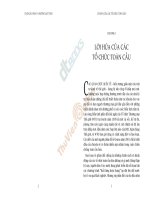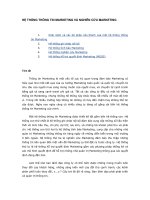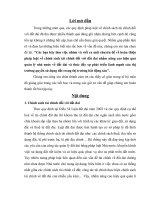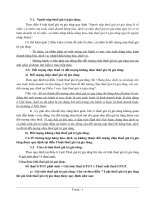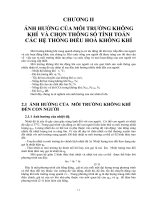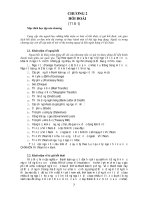2 IAC2014 MSCR mike anderson
Bạn đang xem bản rút gọn của tài liệu. Xem và tải ngay bản đầy đủ của tài liệu tại đây (2.49 MB, 89 trang )
Introduction to the Multiple‐Stress Creep‐
Recovery (MSCR) Test and its Use in the PG Binder
Specification
Mike Anderson, Asphalt Institute
54th Annual Idaho Asphalt Conference
Moscow, Idaho
23 October 2014
Acknowledgments
• DTFH61‐08‐H‐00030 and DTFH61‐11‐H‐00033
• Cooperative Agreements between the FHWA and
the Asphalt Institute
• John Bukowski, AOTR (00030)
• Michael Arasteh, AOTR (00033)
• Asphalt Binder ETG
• John D’Angelo
• Member Companies of the Asphalt Institute
• Technical Advisory Committee
Discussion
• Why do we need a new high temperature
parameter?
• How does the MSCR test work?
• How do MSCR results (Jnr) relate to rutting?
• How can MSCR Recovery be used and what
does it indicate?
• How does the specification work?
• What educational and implementation
activities are going on?
DSR Operation: AASHTO T315
Spindle
Position
One cycle
is complete...
B
A
A
A
C
B
A
C
Time
Shortcomings of G*/sin δ
• G*/sin δ as a High Temperature Parameter
• Properties determined in Linear Viscoelastic (LVE)
region
• No damage behavior
• Rutting is a non‐linear failure
• Polymer‐modified systems engaged in non‐linear region
• Characterizes stiffness
• Related to rutting
Effect of Phase Angle
1.00
Sin
0.98
0.96
0.94
0.92
0.90
60
65
70
75
80
Phase Angle, degrees
85
90
Effect of Binder G*/sin on Mixture
Permanent Shear Strain
25000
RSCH @58C, microstrain
20000
y = 19270.79e-0.09x
R2 = 0.42
15000
10000
5000
0
0.00
2.00
4.00
6.00
RTFO G*/sin , 70C
8.00
10.00
High Temperature Testing
• Repeated Shear Creep
• Analogous to mixture test (RSCH)
• Performed in DSR
•
•
•
•
Controlled shear stress (i.e., 25 Pa or 300 Pa)
100 cycles
1‐second load, 9‐second rest per cycle
High test temperature (HT‐?)
• Response: permanent shear strain (p) or strain
slope
Perm. Shear Strain, %
Repeated Shear Creep
14
12
10
Recoverable shear strain
8
Instantaneous
shear strain
6
4
Permanent
shear strain
2
0
0
2
4
6
Time, seconds
8
10
Repeated Shear Creep
Perm. Shear Strain, %
NCHRP 9-10: PG 82 Binders
Repeated Shear Creep (70C, 300Pa)
14
12
10
8
6
4
2
0
0
2
4
6
Time, seconds
8
10
Perm. Shear Strain, %
Repeated Shear Creep
NCHRP 9-10: PG 82 Binders
Repeated Shear Creep (70C, 300Pa)
14
12
10
8
6
4
2
0
Ox
PE-s
SBS-r
0
200
400
600
Time, seconds
800
1000
Multiple‐Stress Creep‐Recovery (MSCR) Test:
AASHTO T350
• Performed on RTFO‐aged Binder
• Test Temperature
• Environmental Temperature
• Not Grade‐Bumped
• 10 cycles per stress level
• 1‐second loading at specified shear stress
• 0.1 kPa
• 3.2 kPa
• 9‐second rest period
MSCR Test
• Calculate Non‐recoverable Creep Compliance
(Jnr)
• Non‐recoverable shear strain divided by applied
shear stress
• “J” = “compliance”
• “nr” = “non‐recoverable”
• Calculate Recovery for each Cycle, Stress
• Difference between strain at end of recovery
period and peak strain after creep loading
Perm. Shear Strain, %
MSCR
14
12
10
Recoverable shear strain
8
Instantaneous
shear strain
6
4
Non-recoverable (permanent)
shear strain
2
0
0
2
4
6
Time, seconds
8
10
MSCR – Non‐Recoverable Compliance (Jnr)
80
Jnr =
Unrecovered Shear Strain
Applied Shear Stress
70
Strain, %
60
50
Cycle 3 Unrecovered
(permanent) strain
40
Cycle 2 Unrecovered
(permanent) strain
30
20
Cycle 1 Unrecovered
(permanent) strain
10
0
0
5
10
15
20
25
Time, seconds
30
35
40
MSCR – Non‐Recoverable Compliance (Jnr)
0.1 kPa Shear Stress
0.80
0.70
Jnr =
Strain
0.60
Unrecovered Shear Strain
Applied Shear Stress
0.50
Jnr =
0.40
0.197
= 1.97 kPa-1
0.1 kPa
0.30
0.20
0.197
0.10
Cycle 1 Unrecovered
(permanent) strain
0
0
5
10
15
20
25
Time, seconds
30
35
40
Relationship between Jnr and ALF Rutting
Jnr‐25.6
2.5
Jnr = (4.74*Rut Depth) - 1.17
R2 = 0.82
Jnr
2
1.5
MSCR can adjust for field
conditions and has excellent
relations to performance.
1
0.5
0
0
0.1
0.2
0.3
0.4
0.5
ALF Rutting, in
0.6
0.7
0.8
Mississippi I55: 6‐yr rutting
Jnr‐3.2
4
3.5
3
2.5
2
1.5
1
0.5
0
binder
Ultrapave
Styrelf
GTR 80
Sealoflex
Multigrade
Cryo Rubber
Control
0
18
mod
SBR
SB
SBS
2
true grade
70-27
77-29
75-29
82-27
72-24
75-28
70-24
6 yr
rut mm
4.5
2
1.5
3
5
7
11
4
Jnr 3.2 kPa
70C
1.7
0.44
1.21
0.19
2.13
1.62
3.5
6
y = 0.2907x + 0.1297
2
R = 0.7499
8
10
12
Effect of Binder Jnr on Mixture
Permanent Shear Strain
25000
y = 8633.20e0.58x
R² = 0.71
RSCH @58C, microstrain
20000
15000
10000
5000
0
0.00
0.20
0.40
0.60
0.80
1.00
Jnr @3.2kPa, 64C (kPa-1)
1.20
1.40
MSCR: What is % Recovery?
• MSCR Jnr addresses the high temperature
rutting for both neat and modified binders
• but many highway agencies require polymers for
cracking and durability.
• The MSCR % Recovery measurement can
identify and quantify how the polymer is
working in the binder.
MSCR Recovery
3.2 kPa Shear Stress
0.80
Recovery = 100% *
0.70
Peak Strain – Unrecovered Strain
Peak Strain
Strain
0.60
Recovery = 100% *
0.50
0.300 – 0.197
0.300
= 34.3%
0.40
0.30
0.300
0.20
0.197
Cycle 1 Unrecovered
(permanent) strain
0.10
0
0
5
10
15
20
25
Time, seconds
30
35
40
MSCR Recovery:
Validate Polymer Modification
100
The curve stops at J nr = 2 kPa-1. J nr values greater than 2 kPa-1
are not required to have any minimum value of %Recovery.
90
80
Recovery, %
70
Significant
High elasticity
Elastic Response
60
50
40
30
20
10
0 elasticity
Poor
0.00
0.50
1.00
Jnr , kPa-1
1.50
2.00
MSCR Recovery:
Validate Polymer Modification
100
The curve stops at Jnr-3.2 = 2.00 kPa-1 and 0.1 kPa-1. Jnr-3.2
values greater than 2.00 kPa-1 are not required to have any
minimum Rec-3.2 value. Jnr-3.2 values less than 0.10 kPa-1
are required to have a minimum Rec-3.2 value of 55%.
90
80
Rec-3.2, %
70
High elasticity
60
Significant Elastic Response
50
40
30
20
10
0 elasticity
Poor
0.00
0.50
1.00
Jnr-3.2, kPa-1
1.50
2.00
Table for MSCR % Recovery: Minimum Values
Minimum % Recovery for Measured Jnr values
Jnr @3.2 kPa, kPa‐1
Recovery
> 2.00
n/a
≤ 2.00
≥ 30%
≤ 1.00
≥ 35%
≤ 0.50
≥ 45%
≤ 0.25
≥ 50%
≤ 0.10
≥ 55%
Validate Polymer Modification
PG 76-22 Binders: MSCR3200
110
Rec3200 @ 64C, %
100
90
y = 29.82x -0.39
R² = 0.54
80
70
60
50
Recovery = 29.37*Jnr-0.26
40
30
20
0.00
0.10
0.20
0.30
Jnr @ 64C, kPa-1
0.40
0.50
0.60
